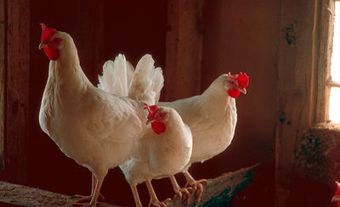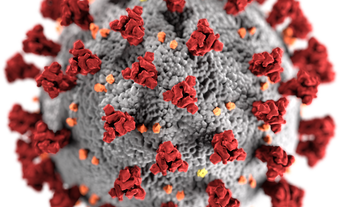Avian influenza, commonly known as “bird flu”, is a contagious viral disease that can affect several species of birds used in food production (e.g., chickens, turkeys), as well as pet birds, wild birds and some mammals (see Poultry Farming). The viruses responsible for the disease can be classified into two categories: high pathogenicity or low pathogenicity. The highly pathogenic H5N1 subtype of the avian influenza virus is transmissible to humans. In Canada, cases of avian influenza must be reported to the Canadian Food Inspection Agency.

Avian Influenza
While first reports of avian influenza (historically called “fowl plague”) date back more than a century, the viruses responsible for this disease were first identified in 1955 as Type A influenza viruses. Avian influenza viruses can be classified into two categories: highly pathogenic avian influenza (HPAI) and low pathogenic avian influenza (LPAI), based on the severity of the illness caused in poultry. (See also Poultry Farming.) HPAI can spread rapidly, causing severe disease and high death rates, whereas LPAI causes mild to no disease and few symptoms. Low pathogenicity forms of the virus are found routinely in wild waterfowl populations, and these birds are the reservoir of all avian influenza viruses.
To date, all HPAI outbreaks have been attributed to the H5 and H7 subtypes of the avian influenza virus. In a poultry population, these subtypes tend to mutate from low pathogenic forms to highly pathogenic forms as the viruses adapt to their host. Highly pathogenic H5 or H7 in poultry is very contagious, and a quick response is necessary to contain and prevent further spread.
Disease outbreaks involving HPAI viruses have been periodically reported in the Americas, Europe, Asia, Australia and Africa. The distribution of HPAI viruses reflect domestic poultry production, migratory routes, time of year and the disease surveillance and reporting systems present. (See also Migration.)
Effect on Human Health
In general, human illness due to infection with avian influenza viruses is rare with minor clinical signs. However, in Hong Kong in 1997 a highly pathogenic H5N1 subtype was transmitted from poultry to humans who were in close contact with sick or dead birds. (See also Poultry Farming.) The virus was recorded in 18 people, 6 of whom died. Since then, the H5N1 subtype has continued to cause outbreaks of disease in wild birds and poultry flocks throughout Asia and greater efforts have been made to control the disease in animals and to prevent transmission to humans. By the spring of 2006, the H5N1 strain had spread to Europe, the Middle East and Africa, possibly through the trade of infected birds or their products and the movements of migratory birds. All H5 and H7 subtypes must be reported to the World Organisation for Animal Health (OIE).
Avian Influenza in Canada
In Canada, avian influenza is a reportable disease under the Health of Animals Act, meaning that all suspected cases must be reported to the Canadian Food Inspection Agency.
Canada's first case of HPAI (H7N3) occurred in March 2004 in a commercial chicken breeder farm in British Columbia (see Poultry Farming). The farm was immediately quarantined and the flock was humanely destroyed. Within weeks, birds on 42 commercial and 11 backyard premises were found to be infected with HPAI. The farm-to-farm movement of people, equipment or birds was likely the primary method for virus spread, but once the virus was introduced into a densely populated region, short-distance airborne transmission from barn to barn through dust contaminated with the virus may have infected nearby flocks.
To contain disease spread, the Government of Canada followed international disease control guidelines. The government initiated a depopulation program that focused on rapidly isolating, containing and eliminating detected cases of avian influenza. Due to the highly infectious nature of the virus, susceptible birds on farms in close proximity to infected premises were also destroyed.
All infected and exposed birds were humanely destroyed, primarily using carbon dioxide gas. Disposal methods included incineration, burial or composting. The outbreak ended in June 2004 and all premises on which HPAI had been detected were thoroughly cleaned and disinfected. Poultry farms were then allowed to begin restocking.
In September 2007, HPAI was reported in Saskatchewan when an H7N3 subtype was detected in a commercial operation. In this case, the disease was contained to one farm and only the birds on that farm had to be destroyed.
In December 2021, an outbreak of the H5N1 strain of avian influenza was detected in Newfoundland and Labrador. In early 2022, the strain was also detected in Nova Scotia, Ontario and Alberta. The Canadian Food Inspection Agency notified the World Organisation for Animal Health (OIE) of the presence of the highly pathogenic virus in Canada.
Prevention, Preparedness and Response
The Canadian Food Inspection Agency collaborates with Government Departments, poultry and egg industries and the scientific community to prevent and limit the spread of avian influenza. Canada's preparedness for avian influenza outbreaks includes measures to enhance biosecurity on Canadian poultry farms and surveillance of the wild bird population in Canada (see Poultry Farming). The annual wild bird survey is designed to monitor for the presence of all avian influenza viruses, but particularly for the H5N1 strain spreading throughout the world.

 Share on Facebook
Share on Facebook Share on X
Share on X Share by Email
Share by Email Share on Google Classroom
Share on Google Classroom





